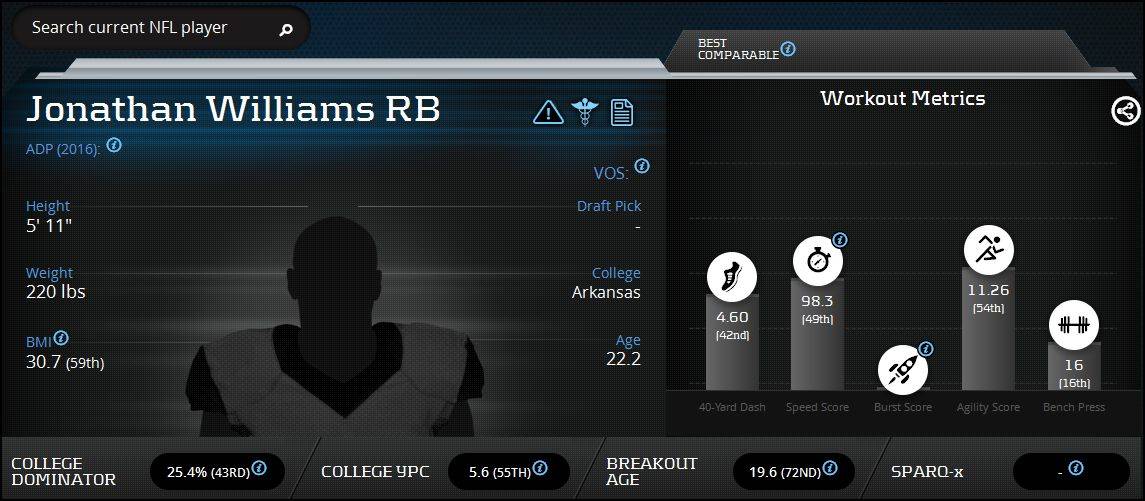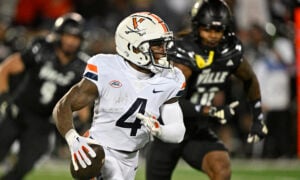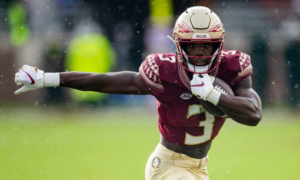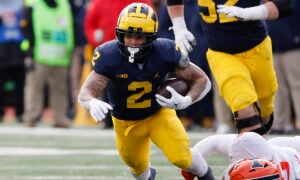Rookie Profile – Jonathan Williams, RB Arkansas
When building my dynasty teams, I often focus most of my capital at the wide receiver position and especially try to reserve my first round rookie picks for them. If possible, I try to acquire multiple second and third round picks to draft running backs who have upside to contribute in an NFL backfield as teams begin to de-value the position and look for lower cost alternatives.
In this year’s rookie class, there are roughly eight to ten running backs that are worthy of top 25 rookie draft picks in dynasty and potentially could be taken in the first 125 picks in the NFL draft. Last season, we found running backs like Jeremy Langford, Karlos Williams, and even Thomas Rawls available in the late second to the fourth rounds of rookie dynasty drafts. One of the running backs that I believe will be this year’s potential gem is Arkansas’ Jonathan Williams.
Unfortunately, he missed his senior year with a foot injury and that has likely moved his draft stock lower than his actual talent warrants. After rushing 211 times for 1190 yards and 12 touchdowns in a near 50-50 split with then sophomore Alex Collins, Williams showed a very good powerful run style.
Although invited to the combine, he did not participate in the field drills and we only have his measurables to compare to similar running backs. Let’s take a look at his Mock Draftable chart.
Amazingly, his size and bench press are a 96.6%, comparable to running back Todd Gurley and unfortunately a 96.2% comparable to Jonas Gray which is quite a disparity in talents. While no one would hold Williams to the level of Gurley as a prospect if his agility drills were part of this comparison, it does highlight that he has the size we like to see from an NFL running back. His 5’11” and 220 pound frame is a solid size. As with Gray, we need more than just size. Although Collins did not participate in drills at the combine, he did run his 40-yard dash, 3-cone drill, 20-yard shuttle, 3-cone drill and 40-yard shuttle at his pro day in front of all 32 teams. While all of these numbers weren’t available at the time of writing this, the reports were positive that he was able to run well despite coming off the foot injury from last year.
Let’s take a look further at some metrics provided by www.PlayerProfiler.com.

While not having the agility numbers, the breakout age score of 73rd percentile jumps out here the most. As a sophomore Williams ran for 900 yards on 150 attempts and four touchdowns. While he wasn’t dominant, he performed well at an early age of 19 years old. His college yards per carry were 5.6, which was higher than T.J Yeldon’s ypc, who is a similar size-and-speed running back as Williams.
Although metrics are very useful pieces of information, my favorite is watching the play on the field. For prospects, we watch film and do our best to identify skill sets that will translate to the NFL game. We want to see an ability to make smart decisions, but also instincts. Ideally, we want to see as many plays as possible in as many different situations as possible. For the most part, we look for an ability to gain yards: plain and simple. The difficulty in that simplicity is whether the methods and means to gain those yards will result in production at the next level. For running backs, this goal can be achieved in many ways, some of the specific skill sets I look for involve balance through contact and vision. I want to see not only does a running back see the play before it develops, but if he has the burst and power to explode through the hole. I also look for a running back’s ability to maintain balance with defenders diving at their legs or continue their burst when faced with contact on their upper body. I often refer to dirty holes, where the offensive line has created a seam, but not a perfectly clear path. Let’s take a look at how Jonathan Williams does as a runner.
[youtube id=”tImD6F-OLOs” align=”center” maxwidth=”1000″]
As with any player evaluation, I love to watch the film and see if the play on the field matches the production. Williams rushed for 145 yards on 22 attempts, including four rushing touchdowns against Texas Tech in 2014. This game showed a lot of different dynamics to his game. Throughout the game, he was lined up in shotgun, I-formation, and single-back. These formations showed that he can run and pass protect in multiple alignments which is promising for his next challenge in the NFL. In this Draft Breakdown video, in the first quarter with 8:42 on the clock, facing a 2nd and 3 from the six yard line, Williams lined up in the I-formation as the tailback with a fullback in front of him. As the play unfolds, he takes the sweep wide, however cuts inside the edge that gets set by the defense. Often, college running backs do not trust their blocking and try to use their burst to get around the edge. This is okay at the college level; however at the NFL level the edge defender is much quicker to protect the edge. Williams cuts up field into the defense, even with a defensive back coming up to fill the hole. He then uses his ability to power through contact and reaches the end zone for a touchdown. This one play shows us many different traits of an NFL running back; traditional formation and play, with vision and trust for his blockers, and physical contact with power to gain yards and in this case get in the end zone.
Later in the game, with 1:36 left in the second quarter, 1st and 10 from the 12 yard line, Williams takes the handoff in a single-back formation and as the play unfolds cuts up into the hole. The impressive part of a runner for me is choosing the correct path even when it isn’t necessarily the cleanest path at first glance. He could have ran to the open space in the flat and tried to take on the cornerback, instead chose to stick with the designed play, and deal with the contact as it came. After he gets through the hole, he then uses the space to his advantage to avoid pursuit of a diving defender and into the end zone for a touchdown.
Throughout the game Williams uses his power and vision well; however another aspect to a game like this shows me that he didn’t wear down. A team in the NFL would be able to pound Williams and wear down a defense, use him in multiple situations, including pass protection. Often in today’s NFL, teams look to substitute personnel based on game flow or a series which may involve pass heavy plays, such as a no-huddle, or some series which might require a slower pace to eat up clock. Williams has the ability to perform both roles as a runner and as a pass protector, however his limitation may come as a receiver. He did not catch many passes in the Arkansas offense and would have to come with some getting used to at the NFL level. As a Patriots fan, I would love to see Belichick draft Williams in the third or fourth round and be able to replace LeGarrette Blount’s role from 2015. He would complement Dion Lewis well as a committee approach that Belichick often employs based on game situation.
Williams will be a player to keep me up late on Friday April 29th to see if he sneaks into the third round. If he slips into Saturday, some team will be getting a second round talent in the fourth. I don’t expect him to fall past the fifth round. For our dynasty rookie drafts, I expect him to go around pick 20 to 26, and would be happy to take him there.
- 2023 Dynasty Fantasy Football Rookie Prospect: Jalin Hyatt, WR Tennessee - April 6, 2023
- 2021 Summer Sleeper: Las Vegas Raiders - August 14, 2021
- 2021 Summer Sleeper: Cincinnati Bengals - August 13, 2021


































































